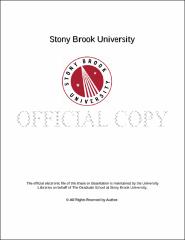| dc.identifier.uri | http://hdl.handle.net/11401/76464 | |
| dc.description.sponsorship | This work is sponsored by the Stony Brook University Graduate School in compliance with the requirements for completion of degree. | en_US |
| dc.format | Monograph | |
| dc.format.medium | Electronic Resource | en_US |
| dc.language.iso | en_US | |
| dc.publisher | The Graduate School, Stony Brook University: Stony Brook, NY. | |
| dc.type | Dissertation | |
| dcterms.abstract | Lyme disease is the most common vector borne disease in the United States. It is caused by a spirochete, Borrelia burgdorferi. One of the aspects of Borrelia infection that has been the focus of investigation is its dissemination from its site of entry to the secondary infectious sites to become systemic. It has previously been shown that B. burgdorferi interacts with the mammalian plasminogen activation system (PAS). In this dissertation, I further investigated the interaction of B. burgdorferi with the PAS. I showed that Borrelia induces urokinase plasminogen activator (uPA) and its physiological inhibitors, plasminogen activator inhibitors 1 and 2 (PAI-l and PAI-2). Induction of uPA resulted in increased penetration of B. burgdorferi across extracellular matrix (ECM) components. Using transmigration assays, I showed that the direct coincubation of B. burgdorferi with monocytic cells, Mono Mac 6 (MM6) cells, and peripheral blood monocytes, enhances bacterial invasion across a barrier coated with fibronectin, mediated by uPA. Moreover, PAI-2 does not have a significant effect on the uPA-potentiated transmigration of B. burgdorferi, showing that bacterial invasion is not hampered by the inhibitor. Using invasion and adhesion assays of two different monocytic cell lines. MM6 and THP-1, I also showed that the interaction of B. burgdorferi with the PAS profoundly affects the invasive ability of monocytic cells due to the induction of PAI-2 by decreasing the adhesive and migratory capacity of the cells. Kinetic studies of the inductions of these proteins revealed that uPA and PAI-2 inductions are temporally modulated to benefit the pathogen in a twofold way. First, the early induction of uPA ensures sufficient time for uPA to bind to the bacteria before it is permanently inhibited by PAI-2. Second, although PAI-2 is induced after uPA, it is induced early enough to inhibit monocyte invasion. Finally, using uPAR deficient mice, it was shown that dissemination of bacteria and the inflammatory infiltration of immune cells were not different in this phenotype. Overall this dissertation showed that the PAS plays a two fold role in the pathogenesis of B. burgdorferi infection, both by enhancing bacterial dissemination and by diminishing host-cell inflammatory migration. | |
| dcterms.available | 2017-09-20T16:50:19Z | |
| dcterms.contributor | Furie, Martha B | en_US |
| dcterms.contributor | Benach, Jorge L | en_US |
| dcterms.contributor | Bliska, James B | en_US |
| dcterms.contributor | Ghebrehiwet, Berhane | en_US |
| dcterms.contributor | Kew, Richard R. | en_US |
| dcterms.creator | Haile, Woldeab Berhane | |
| dcterms.dateAccepted | 2017-09-20T16:50:19Z | |
| dcterms.dateSubmitted | 2017-09-20T16:50:19Z | |
| dcterms.description | Department of Molecular and Cellular Biology | en_US |
| dcterms.extent | 149 pg. | en_US |
| dcterms.format | Monograph | |
| dcterms.format | Application/PDF | en_US |
| dcterms.identifier | http://hdl.handle.net/11401/76464 | |
| dcterms.issued | 2006-08-01 | |
| dcterms.language | en_US | |
| dcterms.provenance | Made available in DSpace on 2017-09-20T16:50:19Z (GMT). No. of bitstreams: 1
Haile_grad.sunysb_0771E_11582.pdf: 4348060 bytes, checksum: e28f9fb0f5d45b6eb784817500a54ea0 (MD5)
Previous issue date: 1 | en |
| dcterms.publisher | The Graduate School, Stony Brook University: Stony Brook, NY. | |
| dcterms.subject | Microbiology -- Immunology | |
| dcterms.subject | Borrelia, Monocytes, PAI-2, Plasminogen, uPA | |
| dcterms.title | The dual role of the Plasminogen Activation System in the dissemination of Borrelia burgdorferi and the inflammatory migration of immune cells | |
| dcterms.type | Dissertation | |

